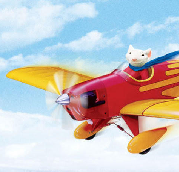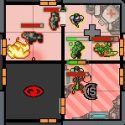|
So let me get this straight. 1. An AoA sensor (not plural) goes crazy and indicates a stall. 2. Based on only this sensor and due to the negative stability induced by the larger engine relative to the 737 NG at high AoA, the computers automatically trim nose down with a significant portion of the total % of horizontal stabilizer trim. 3. If you apply manual electric trim against this input, it will stop MCAS but AoA will be re-checked and MCAS re-activated 5 seconds after manual electric trim is released. Repeated use of trim can allow repeated MCAS activations up to the trim stops. (this detail is at the bottom of the Ethiopian inital report, page 32/33). 4. Yoke control inputs have no input on if MCAS is functioning or not, so pulling back on the control column does nothing to address the root issue. Now we have the branching chain based on what happened to the Lion Air flight and the Ethiopian flight. 5. Lion Air- This system repeatedly detects high AoA from the faulty sensor and repeatedly trims nose down, broken only by the pilots trying to use the manual electric trim. This is not detected mentally as a trim runaway because there are several "checks" against MCAS such as flaps (have to be zero), autopilot (has to be off), and timer (can't have used manual electric trim in the last 5 seconds) which wouldn't apply if the trim motor bugged out. Also, the pilots were distracted by the fact that one stick shaker (left) went off for most of the flight, but not the right side one. Eventually, the airplane trimmed itself so nose down that it became unrecoverable, exacerbated by the high airspeed which made the trimmed horizontal stabilizer more effective relative to elevator inputs.source, parameters page 14 6. Ethiopian- The system repeatedly detects high AoA (74.5 degrees to be specific) from the left AoA sensor starting shortly after takeoff, and trims nose down once the flaps are up. After this happens once or twice, the crew follows Boeing recommended practices and disconnects the electric trim using the cutout switches. However, due to the excessively high airspeed from the nose-level attitude and high thrust, manual use of the trim wheel was ineffective. Additionally, control loads against the high levels of nose down trim were extremely high and exacerbated by the very high airspeed, because the horizontal stabilizer which is trimmed is a much larger surface (and therefore a much more effective control) than the elevator which is controlled by the yoke. Towards the end of the flight, they did turn electric trim (and therefore MCAS) back on, because otherwise they had no control over the pitch attitude due to the high loads on the horizontal stabilizer making manual trim physically extremely difficult, if not impossible. data here, pages 26/27 So Boeing created a system that can, if you cut the electric trim immediately upon realizing MCAS is on the fritz, puts the airplane in an borderline unrecoverable situation. The only way you can correct for the high levels of nose-down trim is to turn the malfunctioning electric trim system back on. This is because at very high indicated airspeeds (trimmed to nose level or nose down at takeoff thrust), manual trim becomes impossible because of the high aerodynamic loads on the horizontal stabilizer. All this can be caused by a single AoA sensor getting stuck or sending bad data. The absolutely correct course of action appears to be to use manual electric trim to neutralize all control forces at the desired pitch attitude and then hit the electric trim cutouts, otherwise MCAS will re-trim nose down in 5 seconds. Also, you now have no stall protection- protection against possibly unrecoverable stalls. Am I missing something? a patagonian cavy fucked around with this message at 07:01 on Apr 5, 2019 |
|
|
|

|
| # ? Apr 26, 2024 15:38 |
|
a patagonian cavy posted:So let me get this straight. This is one of the dumbest causes for multiple crashes I've heard of and Boeings design/business practices should be raised to the ground. What an unbelievable cluster gently caress. All this because they couldn't be arsed to put in a third AOA sensor like every other critical flight system for the last 30 years. gently caress Boeing.
|
|
|
|
Great summary. Shouldn't turning electric trim back on and immediately Ola fucked around with this message at 11:30 on Apr 5, 2019 |
|
|
|
These sorts of decisions being made all over the place almost feel like capitalists know their days are numbered so get as much wealth as late into the game as possible before it all crashes down. I know that stupidity is the better bet, but...
|
|
|
|
|
a patagonian cavy posted:Am I missing something? From what I've been reading that seems to be correct. It's very disconcerting. The area across the street from the delivery center has become a parking lot for MAXs awaiting delivery. The last NG is due to deliver next month. The MAX -10 fuselage just arrived in Renton. All of that isn't good news. I wonder if this ever came up in flight test and what was addressed regarding it.
|
|
|
|
Elviscat posted:There are some sweet overreactions ITT, the 737 MAX is not inherently unstable like an F-16, it suffers from a programming flaw. evil_bunnY fucked around with this message at 09:07 on Apr 5, 2019 |
|
|
|
a patagonian cavy posted:So let me get this straight. The writers on Air Crash Investigation/Mayday are probably already trying to figure out how the gently caress they are going to explain this to the casual viewer.
|
|
|
|
AzureSkys posted:From what I've been reading that seems to be correct. From what Iíve been hearing on the radio, itís wrong, but thatís because the radio producers hilariously misunderstand aviation fundamentals.
|
|
|
|
a patagonian cavy posted:So let me get this straight. Sulphagnist posted:The writers on Air Crash Investigation/Mayday are probably already trying to figure out how the gently caress they are going to explain this to the casual viewer. multi-episode season finale
|
|
|
|
a patagonian cavy posted:So let me get this straight. Kind of. The overspeed was a major contributing factor. And to be clear I'm not blaming the pilots, because the workload at that point was excessive, and the max likes to speed. Even on a normal boring VMC flight at altitude it'll do it. Remove the overspend condition and (presumably) you'd be able to manually trim the stab. Also, you say they switched the electric trim back on, but there's no indication of that in the report. It happened, but how it happened is unclear. Also, to your point 4, MCAS is an automatic anti stall system, so yeah the whole point of it is to trim nose down of the yoke is being pulled back. It's what customers wanted after all those airbusses stalled out of the sky. Unfortunately it's a hacky system that fixed the problem of accidentally stalling an airplane out of the sky by actively flying it into the ground.
|
|
|
Sulphagnist posted:The writers on Air Crash Investigation/Mayday are probably already trying to figure out how the gently caress they are going to explain this to the casual viewer. Well, laying the groundwork for type ratings would be easy enough at least. Something like: Airline pilots get type ratings stating what types of airliners they can fly. Getting a type rating for a given airplane can take several weeks and cost thousands of dollars. But airplanes that are very similar can share a type rating. This allows a pilot trained on one specific aircraft to fly other aircraft of the same type with little to no extra training. (Insert 737 fluff) By 2011, the 737 Boeing Type Rating covered each iteration of the 737 from the 737-100 to the 737-900. Over 7,000 737's were delivered by the end of that year. 2011 was also the year that Boeing started a major redesign of the 737 for the 737-max series. The 737-max series had very different flight characteristics from the previous 737s which could have required a new type-rating. But Boeing engineers had workarounds. One specific workaround had the airplane automatically taking over how it was flown to prevent it from stalling and crashing. This would have tragic consequences. (Cut to commercial break)
|
|
|
|
|
quote:Also, to your point 4, MCAS is an automatic anti stall system, so yeah the whole point of it is to trim nose down of the yoke is being pulled back. It's what customers wanted after all those airbusses stalled out of the sky. Unfortunately it's a hacky system that fixed the problem of accidentally stalling an airplane out of the sky by actively flying it into the ground. New thread title please: "Fixing the problem of accidentally stalling an airplane out of the sky by actively flying it into the ground." Edit: That fits perfectly the definition of "Aeronautical insanity". Brutulf fucked around with this message at 12:45 on Apr 5, 2019 |
|
|
|
I donít always fly into terrain, but when I do, I choose controlled.
|
|
|
|
Jealous Cow posted:I don’t always fly into terrain, but when I do, I choose controlled. 
|
|
|
|
Jealous Cow posted:I donít always fly into terrain, but when I do, I choose controlled. Boeing response: ďdo as you C FITĒ
|
|
|
|
Elviscat posted:There are some sweet overreactions ITT, the 737 MAX is not inherently unstable like an F-16, it suffers from a programming flaw. No dude you can totally Pugachevís Cobra a 737 MAX.
|
|
|
|
Brutulf posted:New thread title please: "Fixing the problem of accidentally stalling an airplane out of the sky by actively flying it into the ground." This should be painted on all Boeing planes now.
|
|
|
|
drgitlin posted:No dude you can totally Pugachevís Cobra a 737 MAX. But you totally can, turns out it's just the nose down version.
|
|
|
|
slidebite posted:But you totally can, turns out it's just the nose down version. Pugachevís Ostrich.
|
|
|
|
Ola posted:Pugachevís Ostrich. Holy poo poo
|
|
|
|
evil_bunnY posted:It's missing 2 AoA sensors and a safety critical flight control software. And because the software wasn't deemed safety critical by the people who sell it, they didn't even catch the basic bitch input sanitization mistake they put into it. I 100% agree, Boeing designed in a system that they decided wasn't flight critical, but which will fly the plane into the ground on a single point failure, from my understanding it doesn't even cross-check the two installed sensors and deactivate if it sees an out of tolerance deviation, like you would expect a non flight critical "pilot aid" feature to do, much less satisfy the 2/3 redundancy you would expect from ANY critical engineering system. It's a fatally flawed system, the current also flawed safety certification scheme failed to catch it, and seems to have actively contributed to the design of the system. I'm not in the aviation industry, but I'm in an engineering field where safety in design and operation can not be compromised, so I like to come to this thread, because of the high-quality posting from Patagonian Cave, Fingerprince Et al who allow me to understand what's going on well, without the background noise of, say, YouTube comments.
|
|
|
|
a patagonian cavy posted:So let me get this straight. Thanks for that summary. From that, it seems like the entire Boeing avionics design process was FUBAR. Add finding another flight control software bug and I can see foreign regulators requiring an new review for the 737-MAX software. That might take a year. To add to Boeing's troubles. They've been working on a Middle of the Market (MoM) airplane design. How much longer will certification for that take if Boeing has to prove it's flight control is trustworthy to Europe and China as well as the FAA? Add another year of flight testing? What an awful series of decisions...
|
|
|
|
What I don't get is why doesn't the MCAS also look at the INUs to verify current orientation of the aircraft? The INUs should show obvious pitch up/pitch down in relation to the external sensors to verify that, yes, the aircraft has entered a stall condition. It seems like MCAS is single point of reference and its overriding the pilot based on a single point of data.
|
|
|
|
Sperglord posted:Thanks for that summary. From that, it seems like the entire Boeing avionics design process was FUBAR. Add finding another flight control software bug and I can see foreign regulators requiring an new review for the 737-MAX software. That might take a year. Their new design is clean sheet, so while it's not impossible for them to gently caress up, it's not as likely to be due to inherent design limitations of a legacy airframe with modern automation bolted/hacked on. Like, they can use 3 AOAs from the start (or smart probes goddamn it!), instead of relying on 2 because adding a third would require redesigning everything.
|
|
|
|
CommieGIR posted:What I don't get is why doesn't the MCAS also look at the INUs to verify current orientation of the aircraft? The INUs should show obvious pitch up/pitch down in relation to the external sensors to verify that, yes, the aircraft has entered a stall condition. The answer is: the MCAS was a hack-job to get the MAX 8 out as fast as possible. Finger Prince posted:Their new design is clean sheet, so while it's not impossible for them to gently caress up, it's not as likely to be due to inherent design limitations of a legacy airframe with modern automation bolted/hacked on. Like, they can use 3 AOAs from the start (or smart probes goddamn it!), instead of relying on 2 because adding a third would require redesigning everything. You're right that the MoM will be a better airplane because it is a clean-sheet. The problem is that Boeing now has to convince the Europe and China, in addition to the soon-to-be-tightened FAA, that the MoM is a good airplane. The existing reports say that the MoM doesn't have a big niche as it stands. The additional cost of higher certification scrutiny will delay it's launch. That's another multi-billion dollar cost for that program.
|
|
|
|
Ola posted:Pugachev’s Ostrich. Perfect.
|
|
|
|
CommieGIR posted:
We'll it's not that it overrode the pilots... the pilots failed to override it.
|
|
|
|
Ola posted:Pugachevís Ostrich. drat thread on fire today Much like a Max 8 shortly after takeoff
|
|
|
|
vessbot posted:We'll it's not that it overrode the pilots... the pilots failed to override it. The pilots followed Boeing's instructions to the letter, per the last known info. MCAS still overrode them and killed them. They already ruled the pilots were not responsible for the crash. And regardless, MCAS was so badly designed that it was assuming a stall based on very minimal info rather than a holistic sensor input.
|
|
|
|
So I'm missing one thing, it appears, from the summary I posted above, and it's an electric/manual trim thing that's been in the 737 from the original type certificate issuance. I wrote that the high aerodynamic loads on the horizontal stabilizer assembly were one of the reasons why manual trim would've been ineffective after an MCAS activation and then electric trim cutout. https://theaircurrent.com/aviation-safety/vestigal-design-issue-clouds-737-max-crash-investigations/ This might be partially correct but isn't the real reason why manual trim wouldn't work- It's because applying nose-up elevator applies opposite force against the jackscrew which actuates the horizontal stabilizer trim. So for the Ethiopian flight, they were hauling back as hard as possible on the yoke to keep the nose up, which prevented manual trim from working at all. The only solution (other than switching the malfunctioning electric trim back on) would have been to relax elevator back pressure and then trim manually, which I'm sure was the furthest thing from their mind because the doomed flight spent almost its entire duration quite close to the ground- relaxing elevator back pressure on the severely out-of-trim airplane would've put the plane in the ground immediately. CommieGIR posted:The pilots followed Boeing's instructions to the letter, per the last known info. MCAS still overrode them and killed them. This is kinda true- MCAS couldn't override them once they hit the electric trim switches, but it had already put enough bad ingredients in the recipe that the situation was possibly already unrecoverable. Upon recognizing they had no manual trim control, they turned electric trim back on and MCAS delivered the coup de gr‚ce. Final report isn't out, of course, so take all this with a decently-big pile of salt.
|
|
|
|
a patagonian cavy posted:This is kinda true- MCAS couldn't override them once they hit the electric trim switches, but it had already put enough bad ingredients in the recipe that the situation was possibly already unrecoverable. Upon recognizing they had no manual trim control, they turned electric trim back on and MCAS delivered the coup de gr‚ce. Well, we hope they turned the electric trim back on because the alternative is worse.
|
|
|
|
Ethiopia said that it thinks the plane hit a bird / flying object on take-off. That broke the AoA probe. Sperglord fucked around with this message at 16:23 on Apr 5, 2019 |
|
|
|
CommieGIR posted:The pilots followed Boeing's instructions to the letter, per the last known info. MCAS still overrode them and killed them. https://theaircurrent.com/wp-content/uploads/2018/11/boeing-737-max-service-bulletin-AOA-680x559.jpeg No, they didn't follow the part that says "Electric stabilizer trim can be used to neutralize control column pitch forces before moving the STAB TRIM CUTOUT switches to CUTOUT." Regardless of the existence of that note, the raw fact remains that they could have overridden the MCAS (as the Lion Air captain successfully did for 20 cycles over 5 minutes) but didn't.
|
|
|
|
vessbot posted:https://theaircurrent.com/wp-content/uploads/2018/11/boeing-737-max-service-bulletin-AOA-680x559.jpeg https://leehamnews.com/2019/04/03/et302-used-the-cut-out-switches-to-stop-mcas/ They were in takeoff speed, which would've required them to try non-checklist items, which they wouldn't have time to do. Your own note says the Lion Air guys had to do it 20 times, and that was just at cruising speed and altitude, not take off.
|
|
|
|
vessbot posted:https://theaircurrent.com/wp-content/uploads/2018/11/boeing-737-max-service-bulletin-AOA-680x559.jpeg They applied some electric trim before switching it to cutout though? Not enough, but still they did it and I'm guessing if they switched it back on it was to try the same thing again except they blipped the trim switch a few times instead of holding it down which would've prevented MCAS from doing its thing? With perfect information and probably a third person in the cockpit the "best" way out of this is to hold electric trim full ANU and hit the cutoff at the value you wanted? Because it sounds like if you blip it MCAS can immediately command full AND stabilizer trim after its activated a couple times.
|
|
|
|
CommieGIR posted:What I don't get is why doesn't the MCAS also look at the INUs to verify current orientation of the aircraft? The INUs should show obvious pitch up/pitch down in relation to the external sensors to verify that, yes, the aircraft has entered a stall condition. I imagine there's a lot of sanity checking that the system could have been doing but didn't. An indicated 74.5 degree angle of attack that doesn't correspond with a high rate of change in altitude (either climbing or stalling) should be suspicious.
|
|
|
|
bull3964 posted:I imagine there's a lot of sanity checking that the system could have been doing but didn't. An indicated 74.5 degree angle of attack that doesn't correspond with a high rate of change in altitude (either climbing or stalling) should be suspicious. Plus throttle position for max power indicating a takeoff/climb versus cruise with nose moving up.
|
|
|
|
bull3964 posted:I imagine there's a lot of sanity checking that the system could have been doing but didn't. An indicated 74.5 degree angle of attack that doesn't correspond with a high rate of change in altitude (either climbing or stalling) should be suspicious. This is the problem with living in the modern digital age and making digital age assumptions, when you're talking about a largely still analog aircraft. The kind of system integration that you'd need to do that level of checking simply doesn't exist, because it's a legacy aircraft that was never designated for that level of integration. There's no common data network on the 737 that would allow that kind of information sharing.
|
|
|
|
Sperglord posted:Ethiopia said that it thinks the plane hit a bird / flying object on take-off. That broke the AoA probe. Makes sense when looking at the data.
|
|
|
|

|
| # ? Apr 26, 2024 15:38 |
|
bobfather posted:Boeing response: ďdo as you C FITĒ Aeronautical Insanity: Do as you C FIT
|
|
|






































